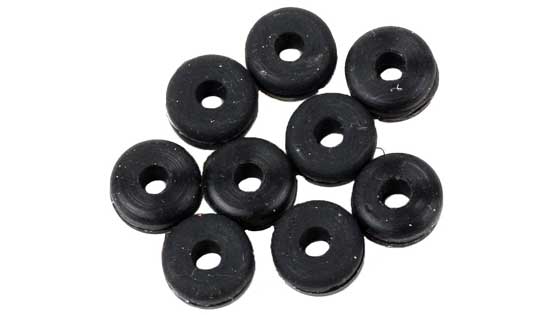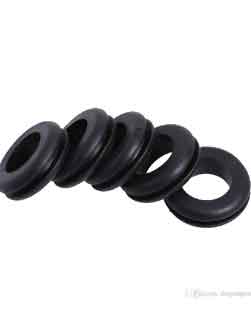A rubber gasket is a mechanical seal that serves to fill the space between two objects in order to prevent leak between two objects while under pressure. In other words, gaskets are used to stop fluid or gas leaks by providing a barrier or a seal between two mating surfaces. The gasket must be able to maintain a seal or block under temperature and pressure changes.
Gaskets are made of cutting from sheet materials, like gasket paper, rubber, metal, silicone, felt, fiberglass, asbestos or a plastic polymer. It is usually recommended that the gasket be made from a slightly compressible material so that it tightly fills the space it is designed for, including any slight irregularities.
Buying Tips for rubber gaskets
The first point the buyer should consider is the The ability of the
gasket to withstand high compressive loads. It is recommended that the
more compressive load exerted on the gasket, the longer it will last. To
measure a gasket material's ability to bear compressive loading, one of
the most popular method is the "hot compression test".
Usually, the manufacturers of gasket materials provide or publish these
results. Besides this, the buyers should consider maximum operating
pressure, operating temperature and electromagnetic and radiofrequency
shielding.


Types of rubber used in making gaskets
- Ethylene Propylene Diene Monomer (EPM, EPDM)
- Fluoroelastomers (FKM)/Viton
- Neoprene
- Nitrile Rubber (NBR)
- Silicone Rubber (SiR)
There are different types of gaskets available such as:
- Sheet or die-cut gasket: Here the gasket material is a flat sheet that can be cut prior to assembly. The sheets are rolled when purchase in long lengths.
- Gasket strip: Here the gasket material is in a strip configuration like weather-stripping material and the strips are produced in many different cross sections like round, channel, C-fold, D-section, square or rectangular, L-section etc.
- Sanitary gasket: They are used in processing pipeline systems for the beverage, pharmaceutical, food, dairy and biotech industries. They are available in various configurations like clamp, bevel seat, flanged, PTFE envelope and others.
- Spiral wound gasket: They are constructed with alternating layers of a soft filler material and a formed metal wire. They may include an inner ring, centering ring or both. The outer centering ring is a compression limiter and the inner ring is radial strength. Due to their resiliency and strength, they are used for a variety of applications.
- Spring finger gasket: These are made of beryllium copper or other EMI shielding material. They are available in strips. These gaskets have spring finger wiping and low closure properties and are also available in a variety of cross sections.
- Tape Gasket: They are of flat or tape construction.
- Window gasket: These are used to seal a glass or plastic window in a sheet metal opening. They are available in a variety of shapes and styles.
- Cured-in-Place (CIP) gasket: These gaskets are applied in precision beads as a liquid to one of the mating surfaces. Sealing or barrier occurs as the elastomer compresses during assembly of the mating parts.
- Formed-in-Place (FIP) gasket: These are applied to one mating surface as a liquid sealant before assembly. After the mating parts are assembled, the FIP gasket spreads and fill all gaps and surface irregularities.
- Coolant gasket: Multiple rubber gaskets are used as seals for liquid coolant by sealing the cavity. Coolant gaskets are available in various shapes, sizes and colors.
- Anti Vibration Mountings
- Automobile Rubber Products
- Calendered Rubber Products
- Extruded Rubber Products
- Medical Rubber Products
- Metal Bonded Components
- Rubber Adhesives & Sealants
- Rubber Ball
- Rubber Bands
- Rubber Beading
- Rubber Bearing
- Rubber Belt
- Rubber Buckets
- Rubber Bullets
- Rubber Cable
- Rubber Coating
- Rubber Duct
- Rubber Expansion Joints
- Rubber Flooring/Matting
- Rubber Footwear
- Rubber Gloves
- Rubber Injection Parts
- Rubber Lining
- Rubber Magnets
- Rubber Molded Products
- Rubber Pads
- Rubber Rollers
- Rubber Stopper
- Rubber Suit
- Rubber Track
- Rubber Valve
- Rubber Balloon
- Rubber Stamps
- Rubber Fenders
- Acrylic Rubber (ACM)
- Butadiene Rubber (BR)
- Butyl Rubber (IIR)
- Chlorosulfonated Polyethylene(CSM)/ Hypalon
- Ethylene Propylene Diene Monomer
- Fluoroelastomers (FKM)/Viton
- Isoprene Rubber (IR)
- Nitrile Rubber (NBR)
- Perfluoroelastomer (FFKM)
- Polychloroprene (CR)/Neoprene
- Polysulfide Rubber (PSR)
- Silicone Rubber (SiR)
- Styrene Butadiene Rubber
How to Make a Custom Rubber Stamp?
Whenever designing a custom stamp for your company, never compromise on its quality because in the end it is the most...
Read MoreLatex and Silicone Rubber Tubing - A Comparison!
Many industries use rubber tubing for various purposes. In fact, various types of rubber tubing are used for different applications...
Read MoreSilicone vs Acrylic Adhesive- A Comparison
Silicon and acrylic adhesives are those rubber adhesives that are widely used in Polyimide tapes. In fact, the polyimide...
Read More

